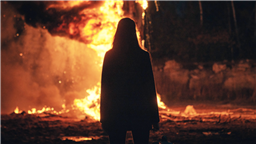Vampirism has been treated as a metaphor for more prosaic addictions in movies before. In “Blood,” however, it’s one more hassle a recovering addict doesn’t need added to the burdens of her already discordant family life. Starring Michelle Monaghan as a mother just out of rehab whose young son gets bitten — then develops an insatiable appetite for the titular fluid — Brad Anderson’s film steers a middle course between dysfunctional domestic drama and supernatural horror. That balance doesn’t completely work. But solid performances and some strong, occasionally unpleasant content make this an involving if not entirely satisfying watch. Vertical Entertainment is releasing it to limited U.S. theaters this Friday, then On Demand platforms Jan. 31.
Having completed a residential program for substance abuse issues never quite defined, Jessica (Monaghan) is back at work as a hospital nurse, and reunited with her kids — though teen Tyler (Skylar Morgan Jones) and younger Owen (Finlay Wojtak-Hissong) are not particularly happy to be moving with her into a remote, rather gloomy old farmhouse inherited from late grandparents.
Even less happy about it is ex-husband Patrick (Skeet Ulrich), who’s had those kids to himself for three years. He’s resentful over Jessica’s uprooting them, as well as doubtful about her recovery: She clearly put them all through the mill. He’s also moved on in establishing a new spousal relationship with Shelley (Danika Frederick), who started as the children’s nanny and is now pregnant with their half-sibling. This doesn’t sit much better with Jessica than his ominous rumblings about winning back full custody.
Easing the transition somewhat, at least for Owen, is his dog Pippin, the kind of golden lab so docile you’d trust it not to hurt the proverbial fly. But Pip seems both drawn and worried by something in the surrounding woods. One night he runs off, and upon finally returning a couple days later is… not himself. Eyes aglow, he seriously attacks Owen, who must be saved by mom at the cost of the dog’s life. Whatever “possessed” Pip soon appears to have passed to his victim, whose recovery is erratic until Jessica realizes he needs blood — not just via transfusion in his hospital bed, but orally, in quantity. Once she gets him back home, supplying that ever-growing need takes the narrative into pretty creepy territory, pretty fast.
Limning a protagonist whose maternal devotion seldom wavers in crossing some appalling lines, Monaghan doesn’t shrink from making Jessica unsympathetic. As she lies, connives and worse to maintain her son’s grotesque habit, it’s no wonder Ulrich’s ex suspects she’s using again. Jones is good as the adolescent who suspects what’s going on before anyone else, while Wojtak-Hissong does well as a child who gradually disappears into feral behavior and creature makeup.
The cruelest aspect of Will Honley’s screenplay is the fate that befalls Helen (June B. Wilde), an older woman who confides her suicidal despair over a terminal cancer diagnosis to her nurse. That intel in turn leads Jessica to some truly horrible rationalizing once she needs a long-term blood “donor” for the little monster at home, voluntary or not. The prolonged, gruesome suffering that ensues is almost more than this film can handle, its queasy aftertaste hardly alleviated when the narrative ultimately renders poor Helen irrelevant.
In feature (as opposed to series) work, Anderson has been reliable in tonally melding the disparate elements of variable screenplays, from the sinister mental-health puzzles of “Session 9” and “The Machinist” to the international intrigue of “Transsiberian” and “Beirut.” Sometimes his material has defeated him, however, as in “Stonehearst Asylum” and “Vanishing on 7th Street.” “Blood” falls somewhere in between: Its psychological realism adds depth to a fantasy-horror hook that itself is somewhat underdeveloped, and which it can’t quite transcend. (We never do find out just who or what the whole vampirism thing came from, beyond an ambiguous connection to a dead tree in a dried-up lake near the farmhouse.)
The story’s shotgun marriage of opposing elements never takes as smoothly as it has in a number of other offbeat bloodsucker screen depictions, from Romero’s “Martin” to “Let the Right One In.” Nonetheless, the director and his collaborators bring some grit and propulsion to a macabre concept. If the effect is often less suspenseful than simply discomfiting (because Jessica’s actions frequently do make it look like she’s relapsed), that too has appeal for certain horror fans.
Shot primarily in Manitoba, the U.S. production has sturdy, handsome, unshowy design elements that reinforce its tonal slant as more a depressing tale of very bad familial luck than an overt dive into the fantastical.
Read More About:
Source: Read Full Article
